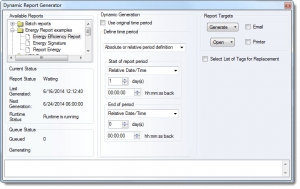You may think a report is a static document that is defined and run on time or event.
 Yes, inferior solutions work that way. But Dream Report is a superior solution. When you create a Dream Report, you automatically get lots of flexibility, with no extra effort at all. For example, you may set up a Dream Report for automatic triggering, on any combination of time, event, day of the week, etc. And, you may select to have that report delivered as a PDF file, Excel or CSV file, attached to an email or dropped in a directory. Easy enough, but that’s to be expected, and is just the beginning.
Yes, inferior solutions work that way. But Dream Report is a superior solution. When you create a Dream Report, you automatically get lots of flexibility, with no extra effort at all. For example, you may set up a Dream Report for automatic triggering, on any combination of time, event, day of the week, etc. And, you may select to have that report delivered as a PDF file, Excel or CSV file, attached to an email or dropped in a directory. Easy enough, but that’s to be expected, and is just the beginning.
With one click of a button, you can also deliver that file to the Dream Report Web Portal. That is where the fun really begins. The Portal will give you a view of your reports (under complete security – of course). You can see your reports, and you can review past reports. But, you can also interact with your reports and trigger them for different periods, and even different uses.
Suppose you created a daily report. In other systems, that is all you get. With Dream Report, that daily report can be triggered with an external date and time picker, enabling you to take that daily report and generate it over the past week, month, year or completely custom period. No report alteration is necessary. Dream Report delivers “Dynamic Generation”, the ability to select a report and change its period on-the–fly. You get Dynamic Generation in the Dream Report Web Portal, but you also get it in the stand alone “Runtime Management Console” and in the RMC Active-X Control – integrated right in your HMI/SCADA or other container solution.
Dream Report understands relative times very well. Want a report to date for the current month – then that’s what you ask for. Want it for the last complete month? That is what “Last” means – the last complete period – Hour, Day, Month, Year, Batch, etc. And of course you can specify an absolute period for the report.
Perhaps you want to select a different set of tags for this custom generation. You may have a report to document the status of a pump, with all the statistics that make sense for a discrete variable – runtime, cycles, max on-time, max off-time, etc. and you want to apply your analysis to another pump, or similarly operating discrete variable. Simple enough, select your Pump Report and “Select a List of Tags for Replacement”. That one report can now be re-applied to another variable, like a valve, motor, compressor, without any formal report customization. If you find that report useful, then set up a “Virtual Instance”, replacing the tags for that new use, and start generating it automatically. It is really that simple.
That’s Dream Report and Ocean Data System’s idea of productivity.

